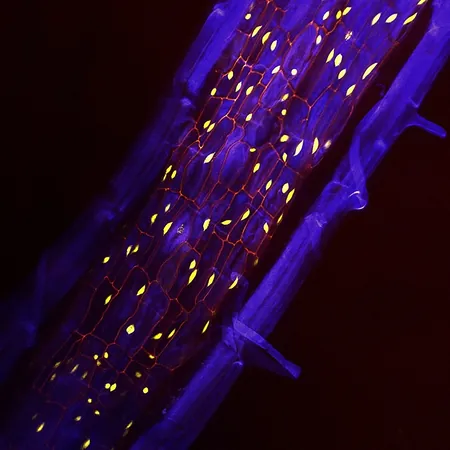
Revolutionary Plant Armor Discovery Could Be Key in the Fight Against Climate Change!
2025-01-09
Author: Sophie
Groundbreaking Study at Salk Institute
In a groundbreaking study, researchers at the renowned Salk Institute have unveiled the first comprehensive gene expression atlas for plant periderm, revealing groundbreaking insights into how this natural armor can help combat climate change and enhance plant resilience against environmental stressors.
The Role of Periderm in Plant Defense
While most animals have the ability to escape threats, plants are rooted in place and must adapt their structure to survive a myriad of challenges including extreme temperatures, drought, and harmful microbes. One of the ways plants defend themselves is through the development of a protective layer known as periderm, particularly around their roots. Surprisingly, the mechanisms behind this later-in-life periderm development had remained largely underexplored – until now.
Innovative Research Techniques
The research team’s innovative work utilized advanced single-cell sequencing techniques, providing a clear view of various cell types within the periderm, their genetic profiles, and the biological processes governing their development. This impressive atlas marks a significant advancement in understanding how plants can fortify themselves against the stresses of a changing environment.
Key Component: Phellem Cell
A key component of the periderm is the phellem cell, which is rich in suberin – a unique molecule with the ability to capture and store atmospheric carbon. With the ongoing challenges of climate change, the researchers aim to exploit this finding to stimulate the growth of the protective periderm in plants, ultimately leading to a boost in their carbon-storing abilities. This initiative aligns with Salk's ambitious Harnessing Plants Initiative, which seeks sustainable methods for capturing carbon through improved plant development.
Professor Wolfgang Busch's Insights
Professor Wolfgang Busch, the senior author of the study, highlighted the importance of plants in mitigating climate change: “They play a crucial role in capturing carbon from the atmosphere while storing it in the soil. By understanding how the periderm forms and matures, we can enhance this natural process and cultivate more resilient plant species.”
Phases of Plant Growth
Plants undergo two phases of growth; initially focusing on root elongation and later transitioning to thickening existing roots and establishing periderm armor. The newly acquired data sheds light on how cells like phellem, phellogen, and phelloderm work together, each serving distinct functions that contribute to the plant’s overall resilience and carbon storage capacity.
Limitations of Historical Studies
Historically, studies on plant periderm have relied on bulk analyses, limiting the understanding of specific cell types. However, this comprehensive approach not only reveals detailed genetic differentiation among periderm cells but also tracks their development over time in Arabidopsis thaliana, a model organism in plant research.
Charlotte Miller's Contributions
Charlotte Miller, lead author of the study, remarked, “This level of detail in understanding plant maturity has never been achieved before. By examining individual cells instead of bulk analysis, we can engineer plants that are better equipped to withstand climate challenges.”
Complex Interplay of Cell Development
The findings also revealed that the development of phellem cells occurs through a complex interplay of genetically distinct yet interconnected phases, driven in part by key regulatory genes like MYB67. The ultimate goal is to harness this information to genetically enhance phellem cells, leading to plants that can sequester more carbon deep in the soil, thereby prolonging carbon storage and reducing atmospheric CO2 levels.
Future Research Potential
Encouragingly, the research has unveiled insights into other essential cell types linked to periderm development, highlighting the exciting potential for future studies that further explore their roles and transitional stages. This information could be crucial for enhancing plant defenses and overall structural integrity in the face of climate threats.
Conclusion
In sum, the Salk Institute’s revolutionary findings not only pave the way for a deeper understanding of plant biology but also hold the promise of creating climate-resilient plants that can act as powerful allies in the global fight against climate change. Scientists continue to explore the fascinating world of plant defenses, taking us one step closer to a more sustainable future!



 Brasil (PT)
Brasil (PT)
 Canada (EN)
Canada (EN)
 Chile (ES)
Chile (ES)
 Česko (CS)
Česko (CS)
 대한민국 (KO)
대한민국 (KO)
 España (ES)
España (ES)
 France (FR)
France (FR)
 Hong Kong (EN)
Hong Kong (EN)
 Italia (IT)
Italia (IT)
 日本 (JA)
日本 (JA)
 Magyarország (HU)
Magyarország (HU)
 Norge (NO)
Norge (NO)
 Polska (PL)
Polska (PL)
 Schweiz (DE)
Schweiz (DE)
 Singapore (EN)
Singapore (EN)
 Sverige (SV)
Sverige (SV)
 Suomi (FI)
Suomi (FI)
 Türkiye (TR)
Türkiye (TR)
 الإمارات العربية المتحدة (AR)
الإمارات العربية المتحدة (AR)